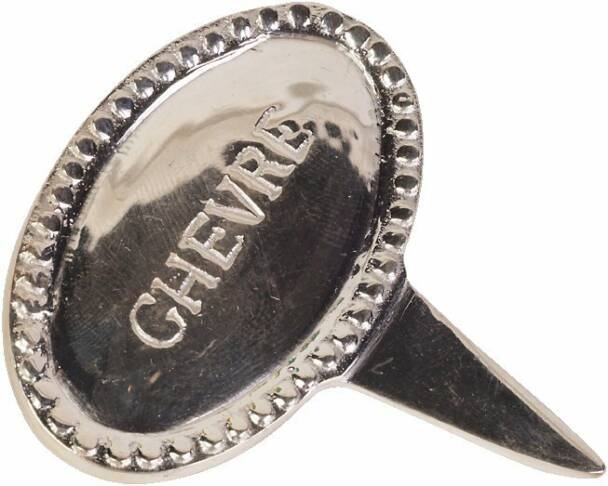
Très Belle Chèvre
Goat Dairy & Fromagerie

From Emeril's Notes From the Kitchen--- February 07, 2002
ARTICLE---The Goat Cheese Lady
The Goat Cheese Lady
By Mary Tutwiler
Wanda's goats like the blues. Old Bouquet chews contentedly from a hanging sack of hay while Lafayette's local radio station KRVS, drop thumbs through the Friday morning show with a low-down version of Key to the Highway, Sonny Landreth on slide guitar. Old Bouquet bleats, two big white cockatoos, Guido and Cotton, call out from the banana trees, "Hi, ya, Hi ya", and Norman, the pot belly pig, grunts his stately way over for a scratch behind the ears. Such is the peaceable kingdom of Belle Ècorce Farms in St. Martinville, Louisiana, in the heart of Cajun country.
Wanda Barras claims that she is an accidental farmer. "I'm just a sucker for animals," she said, absent mindedly patting whichever wooly head- Nubian goat, Great Pyrenees dog, Shetland pony, poodle or pig that nudges against hand. She's been in the exotic bird business for 20 years, hand-rearing parrots and cockatoos for avian fanciers. But the menagerie, including an ever expanding herd of Nubian and Lamancha goats backed her into an elaborate system of fences and feeding, and finally, with overflowing buckets of milk, into the frontier of making goat cheese.
The goat experiment began 3 years ago.
"I went with a friend who was going to buy some goats and they were so sweet, I came home with two. You know you can't have just one. A goat gets lonesome, she needs a companion," Barras said.
By the following spring she had 7 goats and the year after that 18.
"And I hadn't even tasted the milk. I went to the grocery store and bought a quart of goat milk. yuck, it was the most horrible thing you ever tasted!"
Eventually Barras got up the nerve to try her own fresh goat milk.
"It's sweet," she said, delightfully surprised, "and really creamy."
For a while she provided goat milk to people with allergies to cows milk. The goat cheese enterprise began in earnest after a trip to France and Italy, where superb goat cheeses are handmade and offered in every market in every town in those food conscience countries.
"We kept eating cheese and I came home with all these ideas," Barras said.
She began reading, going to seminars and experimenting. And literally discovering, like Little Miss Muffet, that once you get started with a pail of milk you clabber up curds and whey.
Goat milk has a season, starting in late February when the baby goats are born. The milking parlor, at one time consisting of a stool and a pail on Barras front porch, is hospital-clean, air-conditioned, and elevated in tone with Mozart symphonies piped in. "I think the goats prefer classical music when they are being milked, Barras said. It's calming. When my helper, Nicole, milks she plays country music and the goats like that too. But I think Bach makes better cheese.
The milk is quickly chilled, and when Barras has collected a few gallons she pasteurizes it. The addition of vinegar, lemon juice or a commercial culture and rennet causes the milk to separate. Whey is the watery waste that is drained off once the creamy curds coagulate. That first stage of clabbered milk is an old-time country delicacy.
"What you have is fresh cottage cheese," Barras explained.
She pours the curds into cheesecloth to let it drain, then packs it into molds: logs, pyramids, ovals and rounds to produce the traditional shapes of artisan goat cheeses, called chèvre.
At one week old, the cheese is pure white, thick, smooth and creamy. The consistency is moist and spoonable. Slightly aged chèvre, 10 to 14 days is still creamy but has begun to develop the characteristically tart flavor of goat cheese. At 3 weeks the cheese is firm with a distinct, more intense flavor. As the chèvre ages, it dries, beneficial mold begins to form, and the cheese becomes silvered with age and flavors.
Chèvre is a perfect vehicle for spices and flavorings. Barras uses [charcoal] ash, freshly ground black pepper, herbs from her garden, garlic, red pepper, lemon zest, olive oil, fruit, and eau de vie, fruit brandies that she makes herself from raisins, elderberries, pears and cherries, to flavor the cheese.
Barras sells her fresh cheeses at [local farmers’ markets and area gourmet food stores]. Or visit her at Belle Ècorce Farms in St. Martinville where her fresh artisan goat cheese can be purchased while those sweet little goats will butt up against visitors, bleating for a pat on the head.
Belle Ècorce Farms
P. O Box 493
St. Martinville La. 70582
337-394-6683

